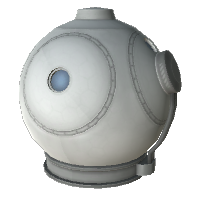Difference between revisions of "KV-1 'Onion' Reentry Module"
m (Rewrote the opening summary to remove ambiguity.) |
|||
| Line 2: | Line 2: | ||
{{:KV-1 'Onion' Reentry Module/Box}} | {{:KV-1 'Onion' Reentry Module/Box}} | ||
| − | The '''KV-1 'Onion' Reentry Module''' is a [[Command Module]] | + | The '''KV-1 'Onion' Reentry Module''' is a [[Command Module]] that can seat 1 [[Kerbal]] crew member during their mission. It, being a crewed command module, can pilot a ship without electricity or a connection to Kerbin. It has no [[SAS]] without a [[Pilot]] [[Kerbal]]. |
== Usage == | == Usage == | ||
Latest revision as of 03:07, 27 November 2022
| Available only with the Making History Expansion installed. |
| KV-1 'Onion' Reentry Module | ||
| Command pod by Probodobodyne Inc | ||
| Radial size | Small | |
| Cost | (total) | 635.00 |
| (dry) | 590.00 | |
| Mass | (total) | 0.770 t |
| (dry) | 0.656 t | |
| Drag | 0.15-0.20 | |
| Max. Temp. | 2400 K | |
| Impact Tolerance | 12 m/s | |
| Research | | |
| Unlock cost | 0 | |
| Since version | 1.4.1 | |
| Part configuration | KV1Pod.cfg | |
| Crew capacity | (maximum) | 1 |
| (required) | 1 | |
| SAS level | × None | |
| Ejection momentum | 10 Ns | |
| Experiment | Crew Report | |
| Collectable | No | |
| Rerunnable | Yes | |
| Resettable | Yes | |
| Electricity required | None | |
| Antenna type | Internal | |
| Antenna rating | 5 km | |
| Ablator | 20 units | |
| Loss at 2000K | 0.05 units/s | |
| Packed volume | None | |
| Inventory Slots | 1 slots | |
| Volume limit | 35 l | |
| Electric capacity | 50 ⚡ | |
The KV-1 'Onion' Reentry Module is a Command Module that can seat 1 Kerbal crew member during their mission. It, being a crewed command module, can pilot a ship without electricity or a connection to Kerbin. It has no SAS without a Pilot Kerbal.
Usage
Generally placed at the top of the rocket, the KV-1 Onion provides basic command module functionality.
It features a 0.625 m radial size node on top, typically used for parts like the Mk16 Parachute, docking ports, service bays, or SAS modules. On the bottom, it has a 1.25m radial node. As the node is part of the heatshield, it includes a "free" decoupler. This decoupler does not take up any additional mass, but can only be fired if the pod is attached to something else. It can also be removed from staging in the VAB if unneeded but note that unlike normal decouplers, this one does not allow crossfeed through the KV-1.
Compared to the Mk1 Command Pod, the KV-1 has comparable cost (590 funds vs 588 with all resources removed), slightly higher temperature tolerance with a small integrated heatshield, slightly lower impact tolerance (12 vs 14 m/s) and empty weight (0.75 vs 0.8 tonnes), but no monopropellant and no reaction wheels. The last one requires extra attention in craft design, else a mission could be curtailed or lost due to limited control options. The first reaction wheel in the tech tree becomes accessible on the same node as the KV-2 which is equivalent to or superior to the KV-1 in all regards except for cost and dry weight, so the only way to use the KV-1 beforehand is either as a secondary command module in tandem with a Mk1 pod (an option slightly cheaper and lighter than using two Mk1 pods) or by expending fuel with a vectored engine (which will not prevent the pod from rolling).
An additional difficulty in using the KV-1 is that its rounded shape gives it significantly higher drag than the Mk1 pod; this is advantageous during reentry but makes the rocket aerodynamically unstable at launch if the KV-1 is not inside a fairing, which is not an option until significantly later in the tech tree. It is thus generally recommended to place the KV-1 as low in the final stage as possible, relying on radially-mounted fuel tanks and engines for the final stage (since the decoupler has no crossfeed, mounting an engine on the bottom node and fuel tanks on the top node will not work). This configuration will still require an additional decoupler on the top node to separate the fuel tanks, as well as a larger than usual number of aerodynamic control surfaces at the base of the rocket (when compared to using the Mk1 pod), but it has a good chance of remaining stable if steered with care.
Note that despite having an integrated heatshield, the KV-1 will not survive reentry at interplanetary speeds without additional protection and the 1.25m heatshield is not wide enough to fully protect it.
Product description
| “ | The design bureau cried when the finance department cried “that’s your lot!” — Probodobodyne |
” |
Trivia
- The part's CFG file suggests that this capsule was originally named "Shallot".
Real-world comparison
The KV-1 was inspired by the Vostok.
Changes
- Initial Release
| ||||||||||||||||||||||||||||||||||||||||||||||||||||||||||
